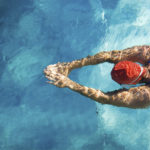AQUA FAT LOSS: THE POOL ISN’T JUST FOR SWIMMING
By Tom Weede with CEO Robert Forster, PT Author of The Complete Waterpower Workout Book
Featured in Men’s Fitness
I’ve got a confession to make. After being faithful to my running program for the past few years, I developed the runner’s version of the seven-year itch. In a word, I was bored. Like a husband who knows the contours of his wife’s body all too well, I had practically memorized every crack in my local sidewalks.
Don’t get me wrong. For calorie burning and overall fitness, running still rules in my book. It’s allowed me to maintain a healthy weight and not feel guilty about my occasional Fatburger runs. And I’m more hooked on my daily endorphin rush than on my morning jolt of caffeine.
But monotony–the bugaboo of any training program–had reared its ugly head in my direction. Seeking an aerobic change of pace, I found myself bobbing in a local pool, feeling kind of ridiculous with a flotation belt strapped around me. It didn’t help when my fiance, Adrienne, who joined me in the pool, snickered at my first awkward attempts at water cardio.
But a few minutes after my clumsy start, I eased into a running motion. And, much to my surprise, the result was a good workout. I worked hard and got my heart rate up, but didn’t take the usual beating of my normal run. By the end of that initial 20-minute session, I’d found a fat-blasting alternative to pounding the pavement.
AQUATIC ADVANTAGES
Aside from being a lively substitute for your usual cardio, water running has plenty of other benefits.
• Because you have to maintain balance, you strengthen oft-neglected areas, like the hip flexors and the stabilizer and core muscles, says Robert Forster, P.T., who uses water exercise as an element of his practice in Santa Monica, Calif., and who co-authored The Complete Waterpower Workout Book (so popular it’s been published in four languages). “That translates to much better function in all your sports, such as skiing, racket sports, running and biking,” he says. And because of the resistance of the water, you’ll get an upper-body workout that hits the pecs, lats and upper arms.
• You’ll also have found a time-efficient full-body workout with minimal impact. “When you push and pull with even intensity, you strengthen two muscle groups in the time it usually takes you to do one,” says Forster. For example, in bringing the leg forward, you work the quadriceps, while the backward-pushing motion works the upper hamstrings and glutes. “In one movement … you’re working both agonist and antagonist [muscles],” says Forster. And the faster you move, the more resistance you’ll encounter, which equates to more work for your muscles.
• Water running is ideal if you’re experiencing back or lower-extremity joint problems that prevent you from traditional running or cycling. “Whatever the problem is … it will tolerate water running at high intensities that you would never get away with if you were running on land,” says Forster, who used a pool to rehabilitate tennis’ Pete Sampras from a back injury.
• Water running is a great way to recover from other land-based workouts and allows you to implement the “hard/easy” method of following an intense training day with a lighter one. By getting your heart rate up moderately (your heart rate is going to be lower in the water than it is on land, because the water pressure helps the venous return of the blood), you’ll get the blood flowing. This will help flush out the lactic acid and other waste buildup in the muscles.
• As an added bonus, you’ll probably find that your land-running form has improved, because you can maintain a higher cadence in water (aim for 30 steps every 10 seconds), which will likely translate to your regular running.
HOW TO WATER-RUN
• Using a tether attached to the side of the pool (use a flotation belt in deep water; it’s optional in shallow water), start running in place. It will take a little practice, but you’ll learn to stay in place without a tether by pulling and pushing with the same intensity (which should be your goal). Use good land-running form, with your head up and your eyes looking ahead. Lean forward slightly, but not too far or you’ll go into a dog-paddling motion. Push your feet directly down and back, and avoid using a cycling leg motion. Keep your elbows at 90-degree angles and lift your knees to 90 degrees. Your hands should be relaxed with thumbs facing up.
• As a variation, try water walking. Imagine yourself marching like a wooden soldier in the water, upright, with your arms and legs straight. “It’s harder than water running because there’s more surface area and longer levers,” says Forster, who adds that you should start easy to avoid injuring your hip flexors. You can make this exercise harder by paddling against the water instead of slicing through it.
• You can also add plyometric training to your workout (and you’ll have a soft landing, which you don’t get on land). Forster recommends a basic lunge, wherein you start by bending your right knee and putting your right foot a stride in front of your left (your left arm is held forward for balance). Then jump and switch arm and leg positions (left leg forward, right arm forward). Forster also suggests trying frog jumps, in which you bounce up, feet together and arms out to your sides at chest level. Lift your knees toward your chest and bring your arms down in front. Then bring your arms back to their original position and your feet back to the floor bottom.
• Doing scissors will work the inner-thigh muscles. With your arms moving gently at shoulder level for balance, and with your legs straight, open your legs about a foot apart and cross your right leg in front of your left. Then cross your left leg in front of your right. (You can also do this exercise without crossing your legs.)
Contact Forster Physical Therapy 310-656-8600 | WATERPOWER PERFORMANCE PROGRAM
GEAR FOR THE CHLORINE CROWD
Essential equipment includes a flotation belt (my local pool rents these for $2) and a tether to help keep you in place. For better grip on the floor bottom, and to keep your feet protected, spring for a pair of water shoes. And don’t neglect your hands: “Simple water gloves with webbed fingers can really increase the resistance of your arm movement,” says physical therapist Robert Forster. Get your Waterpower Gear right here. Or check out www.hydrotone.com.
WATER WORKOUTS (ONLINE)
Do a pool session at least once a week. If you’re new to exercise or just getting back to it, get clearance from your doctor first. Find a pool in which you can submerge yourself to at least chest level, preferably one with a deep end (standing in chest-deep water, you will weigh 10 percent of your out-of-water weight). Then start by doing 20 minutes of easy running, broken up halfway through with a short rest. The next session, add another 10 minutes. Forster offers Waterpower sessions at Forster Physical Therapy with Master Physical Therapist, Ron Berry. Most of you already know that Forster rehabbed Allyson Felix after what was thought to be the end of her Olympic Dream in Rio; but she emerged from Forster’s Waterpower Workouts to set a 2016 world record at the Olympic Trials. Not bad.
After a month, you should be ready to tackle the workouts below. They can be done in either the deep or shallow end, except for the power workout, which should be done in chest-high water. Begin and end each session with five minutes of light jogging. If you’re running for more than 20 minutes, bring a water bottle and rehydrate during your workout as well as afterward.
WORKOUT 1:
STEADY STATE Run at a moderate pace (about 65 percent of maximum effort) for 20 minutes.
WORKOUT 2:
MIX IT UP Do two minutes of scissors, two minutes of water walking, and two minutes of water running (each should be done at about 65 percent to 70 percent of maximum effort). Repeat three to five times.
WORKOUT 3: RUNNING INTERVALS
Sprint at a high intensity (80 percent to 90 percent of maximum effort) for 30 to 60 seconds. Then ease up for 60 seconds. Repeat five to 10 times.
* Recommended only for those with a good aerobic-fitness base.
*WORKOUT 4:
POWER WORKOUT Do lunges for 30 seconds and then frog leaps for 30 seconds. Alternate for five minutes, followed by five minutes of moderate-intensity running.








